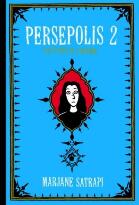Book Review: Marjane Satrapi's Persepolis 2: The Story of a Return
review by anna battista
 Persepolis: The Story of a Childhood, Marjane Satrapi's first volume of her autobiographical comic strip, was defined by the Los Angeles Times as "one of the freshest and most original memoirs of our day", won her the first Fernando Buesa Blanco Peace Prize in Spain and an Alex Award from the American Library Association and was later translated in twelve languages. Satrapi is now back with the second part of her memoir, entitled Persepolis 2: The Story of a Return. This second volume starts where the first had ended, with a young Marjane trying to get used to her new life in Vienna, where her parents sent her to escape the war in Iran. It proves quite difficult for her to integrate in the sexually free Austria, to go to college and find new friends who truly like her and, possibly, to find love. While in Vienna, Marjane seems to be always wrestling with her identity and with her friends' new myths, sex, drugs and Bakunin. She eventually manages to integrate, but, after graduating and winding up homeless on the streets of Vienna, she decides to go back to Iran.
Persepolis: The Story of a Childhood, Marjane Satrapi's first volume of her autobiographical comic strip, was defined by the Los Angeles Times as "one of the freshest and most original memoirs of our day", won her the first Fernando Buesa Blanco Peace Prize in Spain and an Alex Award from the American Library Association and was later translated in twelve languages. Satrapi is now back with the second part of her memoir, entitled Persepolis 2: The Story of a Return. This second volume starts where the first had ended, with a young Marjane trying to get used to her new life in Vienna, where her parents sent her to escape the war in Iran. It proves quite difficult for her to integrate in the sexually free Austria, to go to college and find new friends who truly like her and, possibly, to find love. While in Vienna, Marjane seems to be always wrestling with her identity and with her friends' new myths, sex, drugs and Bakunin. She eventually manages to integrate, but, after graduating and winding up homeless on the streets of Vienna, she decides to go back to Iran.
Once in Teheran, a grown-up Marjane convinces herself that her Austrian experience was a failure compared to what her parents and relatives suffered during the war while she was away. Getting used to life in Iran proves once again difficult for Marjane: thousands and thousands Iranians have died during the war, the walls of many streets are adorned by gigantic murals dedicated to the martyrs of the war while the streets themselves are named after the same martyrs. Marjane tries to get on with her life, wearing the veil and enrolling at the university to study art, yet she also tries to oppose the regime, answering back when a university lecturer talks about how women must dress and shouting back at the police when one day she is stopped for running to catch her bus. "When you run," guards tell her, "your behind makes movements that are… obscene!" "Well then don't look at my ass!" Marjane indignantly answers. After falling in love and getting briefly married, Marjane will decide that the best thing for her is perhaps to leave Iran again once and forever.
Satrapi's minimalist black and white strips have a haunting power: once you start leafing through Persepolis 2, you won't put it down till you reach the last page. Indeed, this book has a universal meaning: many will perhaps recognise themselves in the teenager Marjane growing up, others in the difficulties she has in integrating herself in a different country or in the dilemma she carries within her, between her westernised life in Vienna and her eastern origins.
Satrapi, who now collaborates with various international magazines, is often compared for her work to Art Spiegelman. The only difference between her and Spiegelman is that she tells her stories in an anecdotal fable-like form, to best capture the reality around her and she has proved that this is a winning formula to tell her life and to explain also Iranian history.
Marjane Satrapi is at present working on an animated movie taken from Persepolis and on two new books, one about a man who decides he wants to die after failing to replace a music instrument, another about women storytellers. Satrapi has already proved with the two Persepolis volumes that she has many stories to tell and that she knows how to tell them in her funny, moving and gripping style. You can be sure that her next releases will be as haunting as Persepolis.
Copyright (c) 2005 erasing clouds |
|